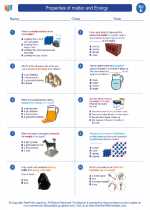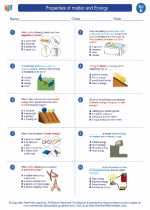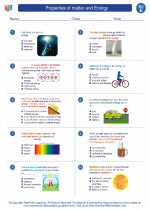Properties of matter and Energy -> thermal energy
What is Thermal Energy?
Thermal energy is the total kinetic energy of the particles that make up a substance. It is related to the temperature of the substance and is a form of internal energy.
How is Thermal Energy Measured?
Thermal energy is measured in units of joules (J) or calories (cal). The amount of thermal energy in an object is directly related to its temperature.
What Factors Affect Thermal Energy?
The amount of thermal energy in an object is influenced by its mass and temperature. The greater the mass and temperature of an object, the more thermal energy it possesses.
Forms of Heat Transfer
There are three main forms of heat transfer: conduction, convection, and radiation. Conduction is the transfer of thermal energy through direct contact, convection is the transfer of thermal energy through the movement of fluids, and radiation is the transfer of thermal energy through electromagnetic waves.
Examples of Thermal Energy
Examples of thermal energy can be found in everyday life, such as the warmth of the sun, the heat from a campfire, or the steam from a hot cup of tea. Thermal energy is also used in various technologies, such as in the production of electricity in thermal power plants.
Conclusion
Understanding thermal energy is important as it plays a crucial role in many natural and technological processes. By studying thermal energy, we can better understand how heat is transferred and utilized in our daily lives.
[Thermal Energy] Related Worksheets and Study Guides:
.◂Science Worksheets and Study Guides Fifth Grade. Properties of matter and Energy

 Worksheet/Answer key
Worksheet/Answer key
 Worksheet/Answer key
Worksheet/Answer key
 Worksheet/Answer key
Worksheet/Answer key
 Vocabulary/Answer key
Vocabulary/Answer key
 Vocabulary/Answer key
Vocabulary/Answer key
